
views
Developing a Budget and Setting a Date

Work with your partner to figure out how much you can spend. Before you set a budget and start preparing for your wedding, you and your partner will need to sit down and look at your income, savings (if you have any), and expenses. Start by writing down how much money you both make each month, then subtract your combined monthly expenses to figure out how much you will have left over. Try to figure out how much you can realistically save between now and when you plan to have your wedding. Then, decide how much of that money you are willing to spend on the wedding as opposed to other expenses. Make sure to take all your expenses into account. This could include things like rent, groceries, cell phone bills, student loan payments, and transportation costs (e.g., gas money and car maintenance). Leave room in your budget for unexpected expenses, like medical bills or vehicle repair costs.

Find out how much your families can contribute (if anything). It can be difficult to ask your family for money. If you have a close relationship with your family, however, there’s a good chance that they would like to help you in some way if they can. Have a direct and forthright conversation with your parents, grandparents, or other loved ones you are close to about whether (and how much) they can chip in. Ask your partner to approach their family as well if they feel comfortable doing so. You might say something like, “Hey, Dad, Christine and I are starting to plan our wedding! We think we can cover the costs of what we have in mind, but it would be a huge help to us if you and Mom could contribute something financially. If not, we understand—just talk it over with Mom and let me know.” Your loved one(s) may want to contribute a certain percentage of the overall costs, or they may have more specific ideas about how they’d like to help. For example, maybe your favorite uncle would like to cover the cost of the wedding bands. Never ask with the expectation that the person you’re asking will be able to help. Be gracious if they say no, and thank them anyway.

Determine how many people you want to invite. Sit down with your partner and put together a guest list. This doesn’t have to be your final list—just try to get a ballpark idea of how many people are going to be at your wedding. Even if your wedding is super simple, a larger number of guests means a bigger budget. The number of guests you invite will affect things like your food and drink budget, the size of the venue you need to reserve, and the number of invitations and wedding favors you will need to order.

Set some spending priorities with your partner. Have a conversation with your partner about what aspects of the wedding are most important to each of you. Each of you can start by writing down a list of “must-haves” and narrowing them down to your top 3. Then, put your 2 lists together and see if they work together. This will help you determine where you want to spend the bulk or your budget. For example, maybe your top priorities are to have a beach wedding, hire an excellent photographer, and have a live band at the reception. Your partner might want to splurge on the perfect tuxedo, keep the guest list as small as possible, and have their best college buddy in the wedding party. You can also make a list of things you’d like to have, but don’t consider necessary (e.g., professionally hand-lettered invitations or a cake designed by a particular baker).

Research typical wedding expenses. Once you have an idea of what you want to spend your money on, do some searching around online to find out what these things are likely to cost. You can also call vendors and venues in your area to get more accurate pricing estimates. Wedding planning websites like Weddingwire.com are good resources for finding typical prices for venues, vendors, and wedding professionals near you.

Look for ways to cut costs. If your budget estimates are turning out a lot higher than what you’re willing or able to spend, take some time to re-evaluate your priorities. Start by looking for items or services that you don’t feel are essential, and cutting them. For example, if you don’t feel the need for custom cocktails at the reception, opt for a simple beer and wine bar, instead. Other ways to cut costs include streamlining your guest list, having your wedding during an off-season period (like winter), and going with sentimental hand-me-downs (like family heirloom rings or your mother’s wedding dress) instead of new designer attire. Do a search online for other cost-saving ideas. Use search terms like “cut wedding costs” or “save money on wedding.”

Save money by asking friends and family for practical help. Another way to cut costs is to ask talented friends and family members to if they can step in and provide some of your wedding services (like photography, live music, or hair and makeup for the bridal party). They’ll probably be honored you asked, and will likely offer a much lower price than a professional would. Don’t expect your loved ones to provide these services for free—always offer to pay something. There’s a chance they’ll offer to do it for free on their own, as a wedding gift to you.

Write a budget spreadsheet. Once you have a decent idea of how much everything is going to cost you, it’s time to itemize your expenses. This will help you keep track of your costs and make sure you are not going over-budget. Make your own spreadsheet, or look for a template online using terms like “wedding budget template.” Make sure you account for the cost of: The venue(s) for the reception and ceremony. Professional services, such as the officiant, photographers, hair and makeup, and music. Food (including the cake) and beverages, including the cost of catering and bartending services, glassware, plates, etc. Décor, including flowers, personalized place settings, wedding favors, table linens, and any rental furniture. Attire and accessories, including the couple’s outfits, clothing for the wedding party (if they are not covering their own expenses), and the rings. Invitations and save-the-dates.
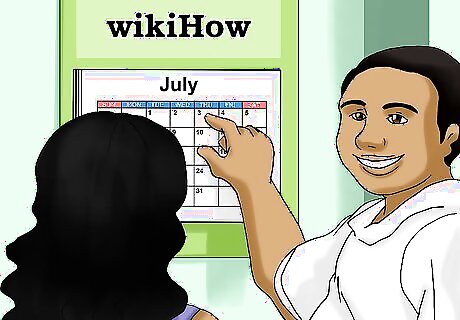
Set a date as early as possible. Putting together a wedding requires a lot of coordination, so try to set at least a general timeframe as soon as you can. This will make it easier for you to plan with party members, vendors, venues, and guests. If there is someone you absolutely have to have at your wedding, have a discussion with them before locking down a date. You may need to be flexible to work around their schedule. Have a discussion with your partner and pick a few ideal dates that work for both of you.
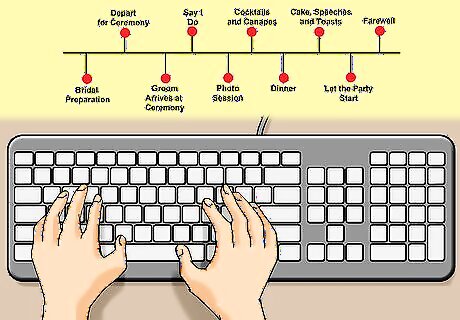
Create a planning timeline. Once you’ve set a date and squared away your budget, you can make the organizational process feel a little more manageable by putting together a timeline. Make a list of all the major tasks you need to get done (e.g., “Hire an officiant,” “Secure a venue,” “Buy a dress”) and set dates or date ranges for accomplishing each one. You can break your timeline down by month or week, or you can use specific dates as deadlines (e.g., “Order the cake by June 27th”). Do a search online for “wedding planning timeline” or “wedding checklist calendar.” There are lots of helpful planning templates available on the web. As the wedding date draws near, you’ll also benefit from having a detailed timeline of the day itself. Work with your officiant, party members, and any vendors/professional service providers to set an exact timeline and make sure everyone is on the same page.
Assembling Your Wedding Party and Guest List

Reach out to people you’d like in your wedding party right away. Have a talk with your partner about who you’d both like to have by your sides on the big day. Once you know who you’d like to be in your party, contact them as soon as you can (preferably at least 9 months in advance) to start working out the details. Depending on how large and elaborate your wedding is, your party may include just 1 or 2 people (e.g., a maid of honor and a best man) or several (such as bridesmaids, groomsmen, a ring bearer, and a flower girl). The larger your wedding party, the more schedules you will have to coordinate. You will also need to discuss whether or not you can help cover costs such as travel and clothing expenses for your party members. Don’t feel the need to have a wedding party at all, if you’d prefer to keep things really simple!
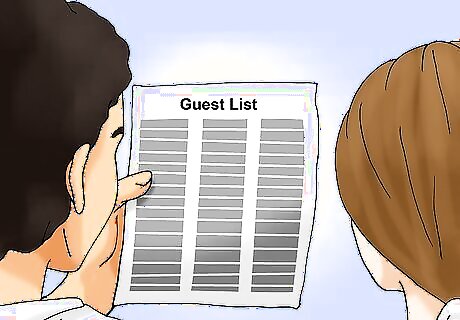
Finalize your guest list. Go through the list of guests that you and your future spouse put together, and decide if there is anyone else you would like to add to (or cut from) the list. Make sure you have up-to-date contact information for everyone on the list. As you continue the planning process, you can use this list to keep track of information such as which guests still need invitations and who has already RSVP’d. Try to have your final guest list written up by at least 9 months before your wedding date.
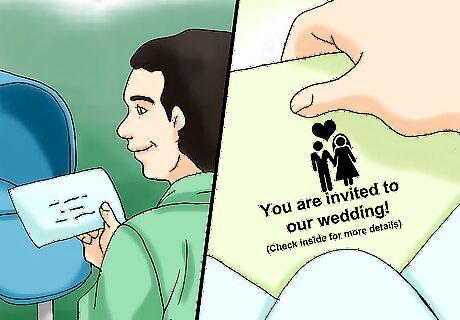
Send out save-the-date cards 6 to 8 months in advance. Save the date cards aren’t an absolute must, but they’re a helpful way to give family and friends a heads up and give them time to clear their schedules. It will also give anyone who can’t attend a chance to let you know well ahead of the wedding. If you’re having a destination wedding or planning your wedding at a time when it might be hard for many people to attend (such as during a major holiday), try to send out save-the-dates 9 months to a year in advance. Do a search online for fun and creative save-the-date ideas, like custom magnets or buttons. If you have a wedding website, you can put the address on your save-the-dates.

Follow up with formal invitations 8 weeks before the wedding. Once the wedding is about 2 months away, send out invitations to all the people on your guest list. Make sure you include the place, date, and time of the ceremony and reception, as well as the names of the people you are inviting. If you don’t have a big budget for wedding invitations, you can save money and add a personal touch by making your own. Your invitations should also include RSVP cards and additional important information, such as dress code and menu options (if applicable). As you receive RSVPs, keep track of them on your guest list.
Choosing a Venue, Officiant, and Vendors

Research venues in your area. Unless you already know exactly where you want to get married, you will need to do some research to find a good venue. Start by doing an online search for venues that match your criteria and fit your budget. Make a list of a few of your favorite options, and contact them for details on pricing, amenities, and how to make reservations. You need not feel restricted to traditional venues, such as a cathedral or banquet hall. You can also get married in a hotel, a park, a museum, a restaurant, or even a barn! Some venues may provide their own music, lighting, catering, or other services. Check with each venue to make sure you are on the same page about what you are providing versus what they are providing. If you can, visit each potential venue in person well in advance of the wedding to make sure they match your expectations.

Reserve your venue(s) 9 to 16 months in advance. Wedding ceremony and reception venues can get booked up quickly, so get your venue(s) locked down as early as you can in order to get the date and time you want. It’s especially important to book early if you’ve selected a popular venue or a popular date (like a Saturday in June). If you’re having a destination wedding, you may need to book your venue even earlier. You’ll need to factor in logistical issues like scheduling flights and arranging hotel rooms.

Choose an officiant 9 to 16 months in advance. You will need plenty of time to find someone who can work with your schedule, fits your budget, and can provide the kind of ceremony you want. Your officiant will also need sufficient time to prepare their script for the ceremony, especially if you want something unique and personal. Depending on where you live, there may be different laws and requirements regarding who can officiate a wedding and what kind of paperwork needs to be completed ahead of time. In some places, you can legally marry without an officiant. For example, if you live in Pennsylvania, you can opt for a Quaker wedding. All you need is 2 witnesses to sign your marriage certificate at the wedding. Take time to develop a rapport with your potential officiant. Make sure your values align, and help them get to know something about you as a couple. If you can, look at reviews and watch videos of any potential officiants performing wedding ceremonies. EXPERT TIP Hope Mirlis Hope Mirlis Wedding Officiant & Marriage Counselor Hope Mirlis is a registered Wedding Officiant, an Ordained Non-Denominational Minister, and a Certified Yoga Instructor specializing in pre-wedding mental health. She is the Founder of A More Perfect Union, a premarital counseling business. She has worked as a counselor and officiant for over eight years and has helped hundreds of couples strengthen their relationships. She has a MFA in Dramatic Arts from the University of California, Davis. Hope Mirlis Hope Mirlis Wedding Officiant & Marriage Counselor A qualified officiant is essential. Hope Mirlis, wedding officiant and pre-marital counselor, adds: "Make sure you hire an officiant that is qualified and has the authority to legally marry you. The ceremony is one of the most important parts — if not, the most important part, of the day. You need to make sure it’s done right."

Get in touch with a photographer and/or videographer. Do an online search for wedding photographers and videographers in your area, and take a look at some portfolios. If you find someone whose work you like and who seems to fit your budget, do a search for online reviews before reaching out to talk to them. Try to meet with your potential photographer/videographer in person, if you can. Bring a list of questions (e.g., about their prices, style, preferred time of day to work, and how long it will take them to return the finished photos/video to you). Book your photographer and/or videographer around 8 months in advance.

Make arrangements with caterers. Assuming your venue doesn’t already provide food and beverage services, you will need to book your own caterers and bartenders. Do an online search for caterers in your area, or try a site like WeddingWire.com or Thumbtack.com to help you find someone who meets your needs. Start meeting with potential caterers around 8 months before the wedding. In addition to finding out about prices, make a list of any other questions you might have for potential caterers (e.g., if they can accommodate guests with food allergies or dietary restrictions).

Arrange transportation to and from your venue(s). About 6 months before the wedding, book transportation for yourself, your future spouse, and the wedding party. If you are having your ceremony and reception at separate locations, take this into account when setting up your transportation. Limos and town cars are popular options for wedding transportation. If you have a large wedding party, a trolley car can be a fun way to go.

Book your florist. Look for a florist who can provide both general décor (such as floral centerpieces) and individual bridal and wedding party bouquets. Let your potential florists know what you are looking for in terms of colors, theme, the quantity of flowers you will need, and the nature of the venue. Make sure that the florist you choose fits your budget. Try to book your florist around 6 months before the wedding.

Hire someone to provide music for the ceremony and reception. You can use websites like GigMasters.com or Thumbtack.com to search for musicians who perform in the style(s) you’re interested in. Contact a few of your favorites to talk about pricing and scheduling. Try to book your musician(s) or DJ around 5 months in advance. If you can, see your potential musicians perform live so that you can get an idea of their sound and how they are with a crowd.

Choose hair and makeup artists. Start getting in touch with hair and makeup experts in your area around 5 months in advance. Bring them pictures of what you have in mind. If you can, schedule hairstyling and makeup appointments with a few of your favorites so you can get a better idea of what they can do. Ask friends and family for recommendations, or look for stylists and makeup artists online.
Buying Your Supplies

Look for aesthetic inspirations. Maybe you’ve already spent a lot of time thinking about what your dream wedding will look like. If not, now is the time to start. Before you start buying attire and supplies, look for inspiration in wedding magazines, wedding websites, and visual inspiration sites like Pinterest. You could even look at photographs of real weddings you’ve attended to get ideas. Get a scrapbook for clippings or put together a virtual vision board with images you like. Consider both small details (like what you want your cake to look like) and the general look or theme you are going for. For example, if you’re having an outdoor wedding in autumn, you might go for a rustic aesthetic with warm, cozy color combinations.

Purchase your wedding attire. If you are a bride, it’s a good idea to purchase your dress about 8 months in advance. You’ll need time to do a few fittings and get any necessary adjustments done in the months leading up to the wedding. Allow at least 6 months for purchasing and fitting dresses and suits for the wedding party. Make sure to bring your wedding shoes along when trying on dresses or suits. This will make it easier to coordinate your outfit and make sure that your hemlines are the right length. Don’t worry about sticking to traditional wedding attire if it’s not your thing. For example, if you’re a bride, maybe you’d rather wear a sleek pantsuit than a lacy wedding dress. You can also consider wearing an outfit or accessory that has sentimental meaning for you, like your dad’s old suit or your grandma’s veil. Consider factors like the overall look, date, and setting of the wedding. For example, you might want to wear a long-sleeved dress if you’re having an outdoor wedding in cool weather.

Buy your rings. Go shopping for wedding bands with your future spouse at least 3 months in advance. This will give you plenty of time to make any needed adjustments, such as sizing changes or engraving.

Order a cake or choose another dessert. Do a search for bakeries that make wedding cakes or other wedding dessert options in your area, and write down a few options that match your style and budget requirements. Some bakers need a lot of lead time to clear their schedules and design the cake, so try to book someone at least 5 months ahead of time. Remember, looks aren’t everything when it comes to cake! Schedule some tastings with potential bakers so you know what you’re getting will be as delicious as it is elegant. If you’d rather not go with a traditional wedding cake, consider alternatives like cupcakes, cake pops, pies, a candy buffet, a hot cocoa bar, or a chocolate fountain. You can even go savory instead of sweet with a cheese wheel cake.

Buy or rent whatever additional supplies you need. Once you’ve ordered the essentials, consider whatever else you may need. Make sure to give your vendors a few months for custom orders, such as personalized wine glasses. For example, depending on what is provided by your venue(s), you may need: Rental chairs, tables, table decorations, and place settings. Decorations in addition to flowers, such as hanging lights, streamers, or banners. Wedding favors, menu cards, and place cards for guests. Programs for the ceremony. Gifts for members of your wedding party.



















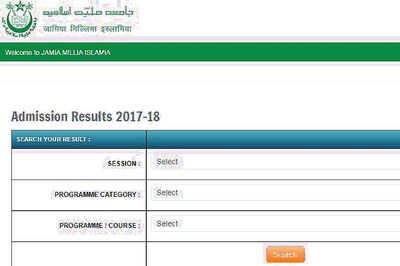
Comments
0 comment